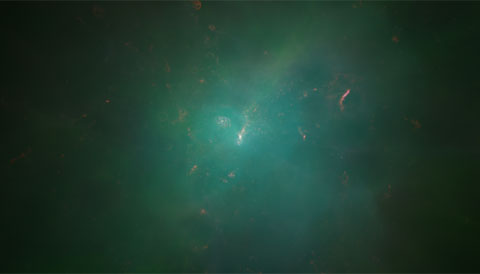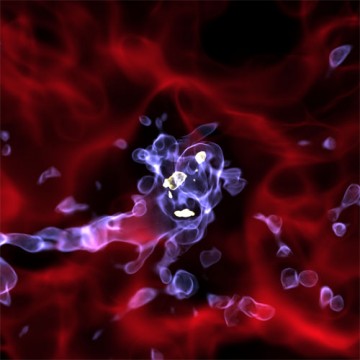Some of the universe’s most luminous galaxies are also the most mysterious. New simulations shed light on how these galaxies formed.

Robert Thompson (NCSA)
When the universe was less than 3 billion years old, it was a markedly different place. It was much smaller and more crowded, teeming with young galaxies. So it’s no surprise that astronomers long thought that galaxy mergers were responsible for submillimeter galaxies, rare and brilliant stellar metropolises that radiate powerfully at wavelengths slightly shorter than microwaves.
Seen only in the distant universe, these bright, churning masses of star formation are unlike anything around today. But they evaded detection until only recently, their stellar construction sites hidden behind clouds of dust. Their discovery comes thanks to submillimeter surveys — dust absorbs visible light but it glows at longer infrared wavelengths, which in turn stretch out as they pass through the expanding universe. Telescopes such as ALMA are now finding these rare gems in greater numbers.
Even as observational astronomers are unveiling a new view of galaxy evolution, theorists are having a heck of a time recreating it. Under the merger scenario, two big galaxies merge into a single giant, stirring up gas and setting off a flash of star formation that fades away after a few tens of millions of years. But theorists applying this scenario haven’t been able to match observations
Now a new simulation published in the September 24 Nature has done just that using an ingredient missing in previous calculations: stars.
More specifically, the key component Desika Narayanan (Haverford College) and colleagues incorporated in their recipe was stellar feedback. Aging and exploding stars drive gas outward, then the massive galaxy’s pull brings it raining back down, akin to a galactic-scale water cycle.
Stars Beget Stars

Desika Narayanan
You might think accounting for stars would be obvious, considering these galaxies are bursting with them —submillimeter galaxies create 500 to 1,000 Suns’ worth of stellar mass every year, up to 1,000 times the Milky Way’s current output. But in cosmological simulations, where computers calculate the effects of gravity on scales on the order of 100 million light-years, making out details on the light-year scale proves all but impossible.
Narayanan and colleagues separate the big picture from the finer details into two stages. First, they simulate a cube of space 16 million light-years on a side at low resolution. As is typical in cosmological simulations, this first calculation only accounts for gravity’s effect on dark matter particles. It ignores the regular matter that makes up stars, assuming dark matter’s pull will draw it in to form galaxies and clusters of galaxies within each dark clump. Once the team identified clumps that would become a submillimeter galaxy, they re-simulated a close-up, high-resolution view, this time including the effects of stars and their winds.
Tracking galaxies’ growth over about 2 billion years, the team found that the starburst (and submillimeter-emitting) phase isn’t a short, merger-inspired flash. It’s a prolonged luminous chapter that lasts roughly 750 million years.
This rotating view drawn from the simulation shows 3D detail of a submillimeter galaxy and its neighbors:
Credit: Robert Thompson (NCSA)
Although the galaxy might well experience mergers during this time frame, those galactic encounters wouldn’t support such intense star formation over such a long period of time. Instead, it’s the stellar feedback that’s maintaining and stirring up a reservoir of gas for future stars.
Mergers vs. Feedback
This study is the latest to question the role of mergers in galaxy evolution — see the September issue of Sky & Telescope for an in-depth look at this sea change.
“It’s an interesting set of results,” agrees Andrew Blain (University of Leicester). But he cautions that the details of stellar feedback are “very substantially more complex” than the simulations included in this work.
The study also doesn’t include feedback from gorging supermassive black holes, which should affect the early evolution of large galaxies, but that’s only a matter of time. Coauthor Philip Hopkins (Caltech) says they’ve already started running similar simulations that include black holes.
“The biggest question is whether the regions described in the paper actually do match the properties [of observed submillimeter galaxies],” Blain adds. Ongoing ALMA observations (such as that of SDP.81 and others) will put this new idea to the test.
For in-depth coverage on recent advances on galaxy evolution, check out the September 2015 issue of Sky & Telescope.
 0
0
Comments
You must be logged in to post a comment.